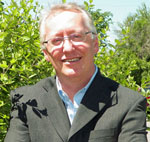 |
||||||||||||
| Subscribe | Past Issues | www.cwwa.ca | Water Source Magazine | ||||||||||||
|
CWWA News
Federal Initiatives
Infrastructure Canada launched a call for applications for the renewed Disaster Mitigation and Adaptation Fund (DMAF). The DMAF is a national, competitive, and merit-based contribution program intended to support infrastructure projects designed to mitigate and adapt to current and future climate-related risks and disasters triggered by natural hazards, such as floods, wildland fires, droughts and seismic events. A maximum acceptable concentration (MAC) of 0.02 mg/L (20 μg/L) is proposed for dimethoate in drinking water. Dimethoate is a broad spectrum organophosphate pesticide used to control a wide range of insects and mites on agricultural and non-agricultural sites. Omethoate is a breakdown product of dimethoate in the environment. It is also produced during treatment of source water containing dimethoate. CWWA’s drinking water Committee is reviewing these documents to determine if the Association should submit comments. Health Canada has reviewed the Guidelines for several pesticides and released revised technical guidance documents. Most of these substances have not been detected by our members at or above the proposed MAC and have not posed concerns for our members. Member News
The Walkerton Clean Water Centre (WCWC) has added a new fact sheet and resources on perfluoroalkyl and polyfluoroalkyl substances (PFAS) in water systems to its Drinking Water Resource Library. PFAS are a large group of synthetic compounds that are often referred to as “forever chemicals”. They are used in a wide variety of industrial and consumer products, such as adhesives, cleaning products, cosmetics and specialized chemical applications, such as fire-fighting foams. This group of chemicals is resistant to heat, water, oils and grease, making them highly persistent in the environment and able to accumulate in living tissues, taking several years to decades for the body to eliminate. Due to their persistent nature, the chemicals can enter drinking water wells by leaching into groundwater. The full fact sheet and related resources can be accessed free of charge through the Drinking Water Resource Library, at: · https://wcwc.ca/wp-content/uploads/2020/12/PFAS-Fact-Sheet-2021-02-23-FINAL-ENG.pdf · https://wcwc.ca/per-polyfluoroalkyl-substances-pfas-pfoa-pfos/ A preliminary class action lawsuit settlement between the Charleston Water System (Charleston, South Carolina) and wipes manufacturer Kimberly-Clark could affect any entity that owned and/or operated wastewater conveyance and treatment systems since January 6, 2018. If water-industry superstars were celebrated like entertainers an introduction to G. Tracy Mehan it wouldn’t be necessary. But water, as industry veterans know, doesn’t quite get the attention it deserves … until services are threatened. At that point, as all along, we turn to our water leaders for answers, which is why I contacted Mehan for this Q&A. On May 18, 2021, the Responsible Plastic Use Coalition (RPUC or Coalition) filed a notice of application with the Federal Court alleging that the designation of manufactured plastic items as a "toxic substance" under the Canadian Environmental Protection Act (CEPA 1999) is unconstitutional and scientifically inaccurate. A group of 27 plastic manufacturers, recyclers, and distributors filed a notice of application with the Federal Court just six days after the designation. Water Canada Recently Indigenous Services Canada provided an update on progress toward clean drinking water in all First Nations communities. As of July 6, 2021, 32 First Nations communities across Canada are working to resolve long-term drinking water advisories. In total, First Nations communities have lifted 108 long-term drinking water advisories restoring reliable access to safe drinking water for 6350 homes and 467 buildings in 79 communities since November 2015. Provincial News
Quebec has published a new draft regulation that would implement a temporary framework for the management of bodies of water to replace the Protection Policy for Lakeshores, Riverbanks, Littoral Zones and Floodplains The full economic impact of B.C.’s watershed sector has been mapped for the first time, revealing that the sector currently contributes 47,900 jobs and $5 billion annually to the B.C. economy. Released recently the new Working for Watersheds report maps the current strength of B.C.’s watershed sector. From entry-level to skilled, seasonal to permanent, technical to policy, and urban to rural, the watershed sector already supports British Columbians at all career stages and specialization levels, and Working for Watersheds shows how B.C. can grow a world-class watershed sector built around securing, restoring, maintaining and improving the health of B.C.’s watersheds Snippings & Clippings
CBC The Springbank off-stream reservoir to protect Calgary from flooding is set to go ahead and will receive up to $168.5 million in federal funding. Federal Environment Minister Jonathan Wilkinson made the announcement in Calgary on Tuesday, and after he approved the project earlier this month in light of a report issued by the Impact Assessment Agency of Canada. northjersey.com New Jersey will replace all its lead water pipes within the next decade in a new plan to comprehensively address the longstanding health hazard lurking in homes and schools throughout the state. Bloomberg Law Wastewater that recently swirled down a toilet bowl may be coming to your tap, in purified form, especially if you’re in a drought-stricken area where drinking water is increasingly scarce. ES&E Magazine A new $200-million Natural Infrastructure Fund is set to invest in large-scale projects that use natural or hybrid approaches to protect the environment. As part of the fund’s Large Project Stream, select major cities with innovative natural infrastructure strategies will be invited to apply for up to $20 million, the government announced. While more details are expected in the weeks to come, the projects should improve well-being, mitigate the impacts of climate change, and prevent costly natural events ES&E Magazine The Halifax Regional Municipality (HRM) of Cogswell will host the first district energy system in eastern Canada to supply renewable energy generated by a nearby wastewater effluent treatment facility to heat and cool buildings. Associated Press Several Los Angeles-area beaches were closed Monday to swimmers and surfers after 17 million gallons of sewage spilled into Santa Monica Bay from a treatment plant. CNN While some major climate provisions have been stripped out of a bipartisan infrastructure deal between the White House and a group of moderate senators, President Joe Biden's vow to replace all of the nation's lead pipes lines is a no-brainer, one of the president's top environmental officials told CNN. Bloomberg Law A June heat wave sparked an earlier-than-expected algae bloom in the drought-ravaged drinking water reservoir in Price, Utah—a sign of climate change-related water quality challenges to come in the tinder-dry West. H2O Global News The western US is in the grips of the worst drought this century, with 93% of the region experiencing drought according to the latest stats released by the U.S Drought Monitor. These dry conditions are damaging crops, increasing the risk of wildfires and placing further strain on already vulnerable water supplies. CBC A watershed group in the Souris area is using a drone to give its members easier access to some of the places that they work. The group received funding to purchase the drone last winter, and members have been using it since then to fly over rivers and streams in the watershed, and to help them plan future projects. Mirage News Every year in Canada, six trillion litres of municipal wastewater are partially treated and released into the environment, while another 150 billion litres of untreated sewage are discharged straight into pristine surface waters. ES&E Magazine New funding is helping researchers across Canada use wastewater surveillance to learn more about how the virus that causes COVID-19 (SARS-CoV-2) is changing over time. In Ontario, researchers at the Children’s Hospital of Eastern Ontario Research Institute, the University of Ottawa and the University of Guelph are working with an investment of more than $338,000 from Genome Canada, Ontario Genomics, and Illumina to develop tests for newer variants, such as the Delta and P1 variants seen in India and Brazil. |
||||||||||||

